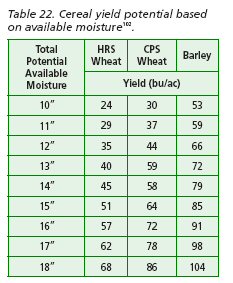Soil Fertility Guide
Appendix
Agronomically, Economically and Environmentally Sensible Target Yields
Most nitrogen and some other nutrient recommendations are based on expected yield goal or target yield. Setting this target yield will have a large effect on the rate of fertilizer or manure recommended, so it is important that a realistic and appropriate level be set.
This yield goal can be estimated in a number of ways. Following are a number of suggestions:
- Developing a base yield.
Develop a base yield based on your historical average for that field and your farm. The base yield can be determined from your own records, or crop insurance records for your area. Consider a recent 5 year average yield, or if yields vary widely, drop the lowest and highest yields and use a 3 year average.
- Consider the field's soil capability and specific production limiting factors such as soil salinity and drainage.
- Once a reasonable base yield is set, add about 5-10% to account for new technology such as new varieties, seeding or fertilizing systems or crop protection products.
- If rainfall and stored soil moisture limit yields, one may choose to use a climate and rainfall probability model to set yield potential. Table 22 contains cereal yield potential based on available moisture from anticipated growing-season rainfall and stored soil moisture (MAFRD Factsheet Moisture and Target Yields ). Stored soil moisture can be measured or estimated prior to seeding based upon the depth of moist soil and soil texture.

You might wish to select a range of moisture conditions for consideration and base your final decision closer to seeding. Also, keep in mind that soil moisture in spring and grain yield at the end of the growing season are often poorly related, unless moisture reserve is large, relative to growing season rainfall. Furthermore, in some fields or regions where excess water is a frequent problem, large moisture reserves may not be helpful for raising yield potential.
Consider the top crop yields that are commonly harvested in your area. These may be from research or test plots or fields under optimum growing conditions. These are the top yield potential for your area and will not be achievable every year. When using these values, ensure that your own practices (e.g. timeliness of seeding, weed control, etc.) are consistent with these high yields. In most cases this approach would need downward adjustment in this base yield to account for production limiting factors in fields.
Your target yield is reasonable when they are actually achieved. Your target is too low if it is exceeded 2 years in 5 and too high if it is never achieved.
For further information, contact your MAFRD GO Representative.
